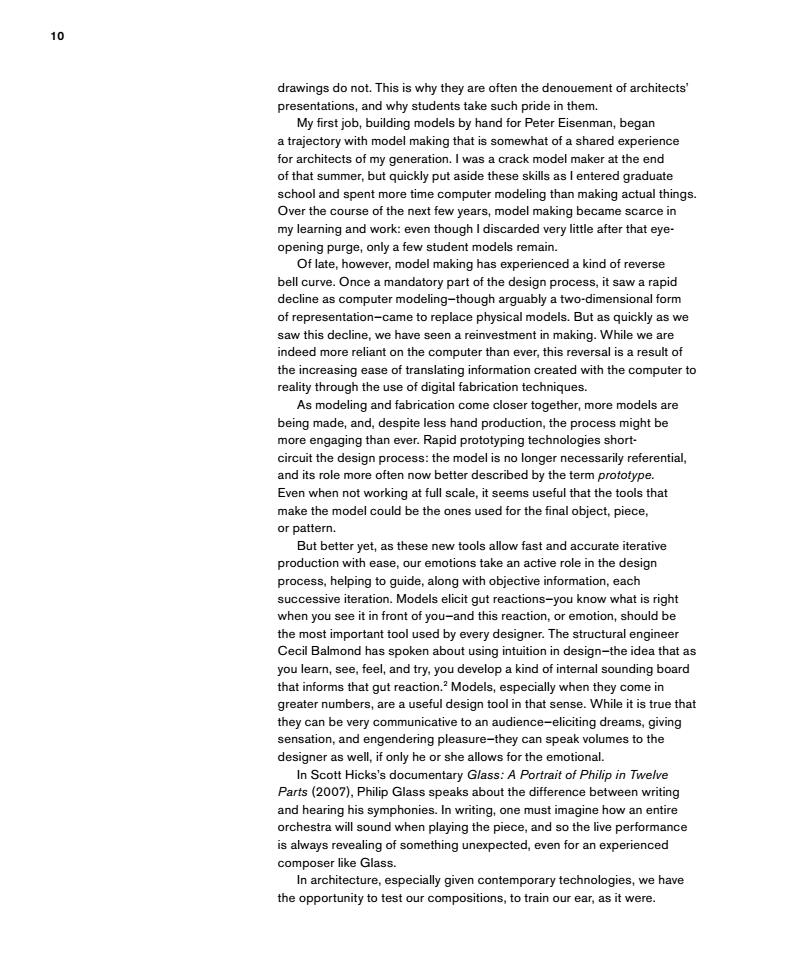正在加载图片...

10 drawings do not.This is why they are often the denouement of architects' presentations,and why students take such pride in them. My first job,building models by hand for Peter Eisenman,began a trajectory with model making that is somewhat of a shared experience for architects of my generation.I was a crack model maker at the end of that summer,but quickly put aside these skills as I entered graduate school and spent more time computer modeling than making actual things. Over the course of the next few years,model making became scarce in my learning and work:even though I discarded very little after that eye- opening purge,only a few student models remain. Of late,however,model making has experienced a kind of reverse bell curve.Once a mandatory part of the design process,it saw a rapid decline as computer modeling-though arguably a two-dimensional form of representation-came to replace physical models.But as quickly as we saw this decline,we have seen a reinvestment in making.While we are indeed more reliant on the computer than ever,this reversal is a result of the increasing ease of translating information created with the computer to reality through the use of digital fabrication techniques. As modeling and fabrication come closer together,more models are being made,and,despite less hand production,the process might be more engaging than ever.Rapid prototyping technologies short- circuit the design process:the model is no longer necessarily referential, and its role more often now better described by the term prototype. Even when not working at full scale,it seems useful that the tools that make the model could be the ones used for the final object,piece, or pattern. But better yet,as these new tools allow fast and accurate iterative production with ease,our emotions take an active role in the design process,helping to guide,along with objective information,each successive iteration.Models elicit gut reactions-you know what is right when you see it in front of you-and this reaction,or emotion,should be the most important tool used by every designer.The structural engineer Cecil Balmond has spoken about using intuition in design-the idea that as you learn,see,feel,and try,you develop a kind of internal sounding board that informs that gut reaction.?Models,especially when they come in greater numbers,are a useful design tool in that sense.While it is true that they can be very communicative to an audience-eliciting dreams,giving sensation,and engendering pleasure-they can speak volumes to the designer as well,if only he or she allows for the emotional. In Scott Hicks's documentary Glass:A Portrait of Philip in Twelve Parts(2007),Philip Glass speaks about the difference between writing and hearing his symphonies.In writing,one must imagine how an entire orchestra will sound when playing the piece,and so the live performance is always revealing of something unexpected,even for an experienced composer like Glass. In architecture,especially given contemporary technologies,we have the opportunity to test our compositions,to train our ear,as it were.10 drawings do not. This is why they are often the denouement of architects’ presentations, and why students take such pride in them. My first job, building models by hand for Peter Eisenman, began a trajectory with model making that is somewhat of a shared experience for architects of my generation. I was a crack model maker at the end of that summer, but quickly put aside these skills as I entered graduate school and spent more time computer modeling than making actual things. Over the course of the next few years, model making became scarce in my learning and work: even though I discarded very little after that eyeopening purge, only a few student models remain. Of late, however, model making has experienced a kind of reverse bell curve. Once a mandatory part of the design process, it saw a rapid decline as computer modeling—though arguably a two-dimensional form of representation—came to replace physical models. But as quickly as we saw this decline, we have seen a reinvestment in making. While we are indeed more reliant on the computer than ever, this reversal is a result of the increasing ease of translating information created with the computer to reality through the use of digital fabrication techniques. As modeling and fabrication come closer together, more models are being made, and, despite less hand production, the process might be more engaging than ever. Rapid prototyping technologies shortcircuit the design process: the model is no longer necessarily referential, and its role more often now better described by the term prototype. Even when not working at full scale, it seems useful that the tools that make the model could be the ones used for the final object, piece, or pattern. But better yet, as these new tools allow fast and accurate iterative production with ease, our emotions take an active role in the design process, helping to guide, along with objective information, each successive iteration. Models elicit gut reactions—you know what is right when you see it in front of you—and this reaction, or emotion, should be the most important tool used by every designer. The structural engineer Cecil Balmond has spoken about using intuition in design—the idea that as you learn, see, feel, and try, you develop a kind of internal sounding board that informs that gut reaction.2 Models, especially when they come in greater numbers, are a useful design tool in that sense. While it is true that they can be very communicative to an audience—eliciting dreams, giving sensation, and engendering pleasure—they can speak volumes to the designer as well, if only he or she allows for the emotional. In Scott Hicks’s documentary Glass: A Portrait of Philip in Twelve Parts (2007), Philip Glass speaks about the difference between writing and hearing his symphonies. In writing, one must imagine how an entire orchestra will sound when playing the piece, and so the live performance is always revealing of something unexpected, even for an experienced composer like Glass. In architecture, especially given contemporary technologies, we have the opportunity to test our compositions, to train our ear, as it were